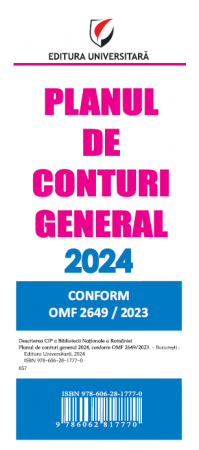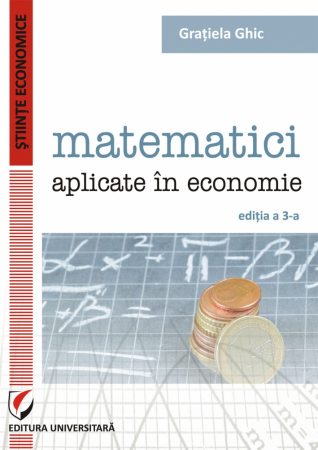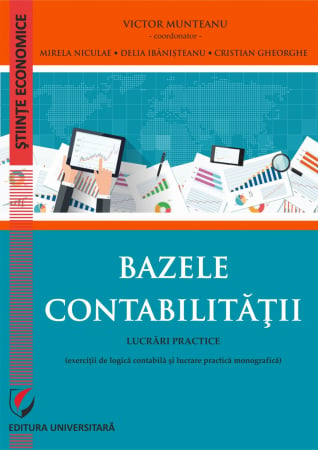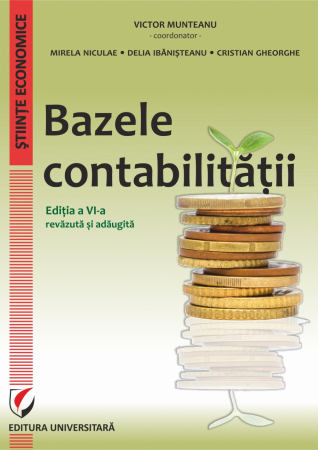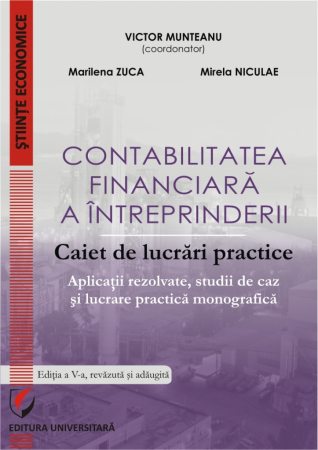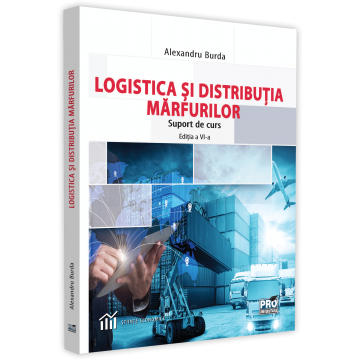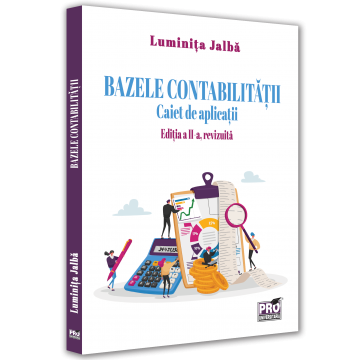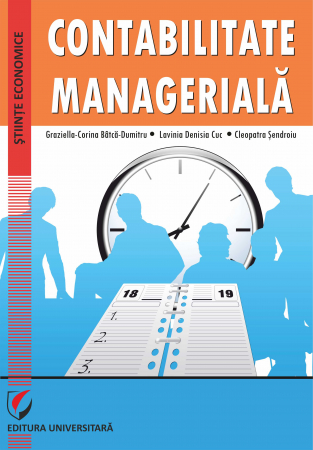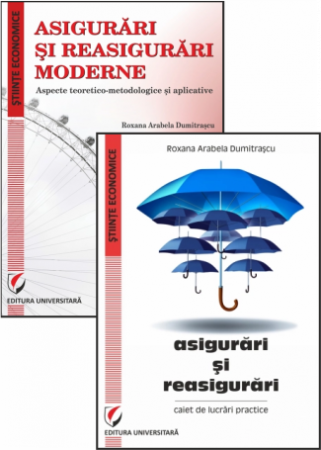Manuscript proposals: [email protected] / 0745 204 115 //// Tracking orders Individuals / Sales: 0745 200 357 / Orders Legal entities: 0721 722 783
ISBN: 978-606-28-0903-4
DOI: 10.5682/9786062809034
Publisher year: 2019
Pages: 366
Publisher: Editura Universitară
Author: Georgeta Ilie
Product Code:
9786062809034
Do you need help?
0745 200 357
- Description
- Download (1)
- Authors
- Content
- More details
- Reviews (0)
This paper aims to present a set of tools to provide the basis for training the skills needed by any manager. In a schematic graphic form, the essential elements specific to project management, business plan, feasibility study, completed with aspects regarding the components of the business environment or the identification of business financing sources, including the conditions and steps, are brought in a single paper. for expanding a business abroad.
During the development of the book, a series of application works are provided that offer the possibility to learn the skills necessary to develop and implement a project, business plan or feasibility study, including from the perspective of successful development of a project to qualify for European funding. .
The book is addressed to all those who consider that they have identified an ingenious business idea for a particular target customer segment or who want to join forces with other partners in achieving a common goal related to the successful implementation of a business idea, but more elected to students, masters, employees with direct responsibilities in writing and carrying out business plans or in approving business loans.
During the development of the book, a series of application works are provided that offer the possibility to learn the skills necessary to develop and implement a project, business plan or feasibility study, including from the perspective of successful development of a project to qualify for European funding. .
The book is addressed to all those who consider that they have identified an ingenious business idea for a particular target customer segment or who want to join forces with other partners in achieving a common goal related to the successful implementation of a business idea, but more elected to students, masters, employees with direct responsibilities in writing and carrying out business plans or in approving business loans.
-
Business Tools. Project Management. Business Plan. Feasibility Study
Download
GEORGETA ILIE
INTRODUCTION / 15
1 BUSINESS ENVIRONMENT / 17
1.1 Segmentation of the business environment / 17
1.2 Analysis of the business environment from the investment perspective / 20
1.3 Analysis of the business environment from the perspective of the relationships generated by starting and developing a business / 21
1.4 Elements in identifying opportunities and creating a successful business structure / 23
PART I / 27
PROJECT MANAGEMENT / 27
2 INTRODUCTORY ELEMENTS: PROJECT, PROJECT MANAGEMENT / 27
3 PROJECT MANAGEMENT CHARACTERISTICS / 29
3.1 Stakeholders in the implementation of a project / 29
3.2 Characteristics of a project / 30
3.3 Project documentation / 32
3.4 Advantages versus disadvantages of project management / 32
3.5 Success versus project failure / 33
3.6 Principles used in project management / 35
4 LOGICAL MATRIX / 36
4.1 The content of the logical matrix / 37
4.2 The stages of the logical analysis of a project / 43
4.3 Functioning of the logic matrix / 45
4.3.1 Vertical logic / 45
4.3.2 Horizontal logic / 47
4.4 The stages of elaborating a project using the logical matrix / 49
4.5 Final verification of the quality of the logical matrix / 58
4.6 Advantages and limits of the logical matrix / 59
5 PROJECT LIFE CYCLE (PROJECT PHASES) / 62
5.1 Initiating the project / 64
5.2 Project planning / 65
5.2.1 Steps of the project planning process / 68
5.2.2 Management documents used in project planning / 78
5.3 Project execution / 82
5.4 Project monitoring and control / 83
5.5 Completion of the project / 85
6 GANTT DIAGRAM / 86
6.1 General presentation / 86
6.2 Advantages versus disadvantages of using the Gantt diagram / 86
6.3 Steps for building the Gantt chart / 88
6.4 Graphic illustration of the Gantt chart / 88
7 NETWORK SCHEDULING / 86
7.1 Program Evaluation and Analysis Technique (PERT Diagram) / 96
7.2 Critical Path Diagram (CPM Diagram) / 100
7.2.1 PERT and CPM - Differences / 101
7.2.2 Stages of elaboration of the project plan / 102
7.2.3 Analysis of projects by PERT / CPM methods / 104
7.2.4 Critical Path Example / 104
7.2.5 Project management through critical chain / 106
8 PROJECT BUDGET / 107
8.1 Defining the project budget / 107
8.2 Types of project budgets / 108
8.3 Budget of a project financed from European funds / 108
8.4 Requirements regarding the elaboration of the budget of a project / 110
8.4.1 General recommendations / 110
8.4.2 Requirements for drawing up a budget for a project financed by European funds / 112
9 SOFTWARE PROGRAMS USED IN PROJECT MANAGEMENT / 113
10 QUALITY MANAGEMENT IN PROJECTS / 117
11 PROJECT MANAGER AND TEAM TRAINING / 119
11.1 Activities specific to the project manager / 119
11.2 Project team / 121
11.3 Competences and profile of a project manager / 121
11.4 Establishing the type of project organization / 123
11.4.1 Pyramidal organization / 123
11.4.2 Matrix organization / 124
PART II-A / 125
INVESTMENT PROJECT MANAGEMENT / 125
12 INTRODUCTORY ELEMENTS / 125
12.1 The concept of investment / 125
12.2 Typology of investment project objectives / 126
12.3 The structure of an investment project / 129
12.4 The investment process / 131
12.5 Characteristics of investment projects / 135
12.6 Defining elements of investment management / 136
13 INVESTMENT PROJECT EVALUATION INDICATORS / 137
13.1 General indicators / 137
13.2 Basic indicators of the investment process / 139
14 DYNAMIC INDICATORS FOR DETERMINING THE ECONOMIC EFFICIENCY OF INVESTMENT PROJECTS / 150
14.1 The influence of the time factor on the investment process / 150
14.2 Update technique / 152
14.3 Economic efficiency of investments / 156
14.3.1 The notion of economic efficiency of investments / 156
14.3.2 The need for economic efficiency calculations in the evaluation of investment projects / 157
14.4 Dynamic indicators for calculating the economic efficiency of investments / 158
15 EVALUATION OF THE EFFICIENCY OF INVESTMENT PROJECTS THROUGH B.I.R.D. / 161
15.1 Peculiarities of the IBRD / 162 methodology
15.2 IBRD / 163 methodology indicators
16 COST-BENEFIT ANALYSIS IN INVESTMENT PROJECTS / 168
16.1 Importance of cost-benefit analysis in investment projects / 168
16.2 Stages of cost-benefit analysis / 171
PART III-A / 177
BUSINESS PLAN / 177
17 INTRODUCTORY ELEMENTS / 177
17.1 The usefulness of the business plan / 177
17.2 Variants of structures for the elaboration of a business plan / 178
18 CONTENT OF A BUSINESS PLAN / 182
18.1 Summary of the proposed business idea / 182
18.2 Description of the company that implements the business plan / 182
18.3 Business objectives, vision and strategy / 184
18.3.1 Objectives / 184
18.3.2 Vision / 186
18.3.3 Business strategy / 186
18.4 Justification of the project in the context of presenting the business history (for existing businesses) or identifying a new business idea (for businessnew maples) / 187
18.4.1 Presentation of the business evolution / 187
18.4.2 The context of identifying a new business idea (for new business) / 190
18.5 Management and human resources / 190
18.6 Market analysis / 192
18.6.1 Current market (for an existing business) / 192
18.6.2 New product / service market / 196
18.6.3 Marketing strategy / 204
18.6.4 Activities to promote the sales of the new product / 205
18.7 Description of the production process / 206
18.7.1 Synthetic description of the technological process / 206
18.7.2 Environmental impact / 206
18.8 Necessary investments / 206
18.8.1 Investment realization chart / 207
18.8.2 Description of investment financing sources / 207
18.8.3 Description of the proposed investment in the context of the technological process / 207
18.8.4 Utility insurance / 208
18.8.5 Necessary modifications to existing equipment / buildings / 208
18.8.6 Necessary changes in the structure and number of employees / 208
18.9 Operating income and expenses / 208
18.9.1 Annual revenues from production / 208
18.9.2 Risks influencing the forecast / 209
18.9.3 Analysis of operating costs (after the implementation of the investment) / 209
18.10 Financial projections / 212
18.10.1 history of economic indicators (if applicable) / 216
18.10.2 Cash-Flow Financial Projections / 217
18.10.3 Simplified cash flow statement / 223
18.10.4 Profit and loss account / 224
18.10.5 Simplified balance sheet / 225
19 MODEL BUSINESS PLAN FOR ACCESSING EUROPEAN FUNDS / 227
PART IV-A / 239
FEASIBILITY STUDY / 239
20 INTRODUCTORY ELEMENTS / 239
20.1 Pre-feasibility study / 240
20.2 Feasibility study / 244
20.3 Financial Analysis / 249
20.3.1 Objectives of the financial analysis / 249
20.3.2 Performance indicators specific to the financial analysis / 250
20.4 Economic analysis / 261
20.4.1 The role and objectives of economic analysis / 261
20.5 Risk and sensitivity analysis / 265
20.6 Cost-Benefit Analysis (CBA) / 268
20.6.1 Importance and objectives of CBA / 268
20.6.2 Specific elements CBA / 269
20.6.3 Stages ACB / 275
21 CASE STUDY. FEASIBILITY STUDY ON THE EFFICIENCY OF AN INVESTMENT PROJECT / 280
21.1 General data about the investment objective / 280
21.1.1 Short presentation of the project / 280
21.1.2 Estimating the cost of the project and staggering the investment expenses during the execution period / 281
21.1.3 Financing the investment project / 283
21.1.4 Estimation of operating revenues and expenses over the life of the project / 284
21.2 Calculation of depreciation and residual value / 286
21.3 Analysis of the credit repayment capacity and of the self-financing capacity / 290
21.3.1 Credit repayment capacity analysis / 290
21.3.2 Self-financing capacity analysis / 292
21.4 Economic analysis and financial analysis of the investment project / 295
21.4.1 Financial Analysis / 295
21.4.2 Economic analysis / 302
21.5 Sensitivity analysis / 307
22 MODEL OF FEASIBILITY STUDY FOR THE FINANCING OF TOURIST ACTIVITIES FROM EUROPEAN FUNDS / 312
PART V-A / 323
FINANCING OF INVESTMENT PROJECTS / 323
23 SOURCES OF FINANCING INVESTMENT PROJECTS / 323
23.1 National sources of investment financing / 323
23.2 International sources of financing investment projects / 332
24 EUROPEAN FUNDS - SOURCE OF FINANCING BUSINESS PROJECTS IN ROMANIA / 335
24.1 Structural and cohesion funds, operational programs, their objectives for the period 2007-2013 / 335
24.2 Europe 2020 Strategy - objectives, priorities, initiatives / 337
24.3 European funds for the period 2014-2020 - synthetic presentation / 338
24.4 Stages of accessing and obtaining European funds / 340
25 RISKS ASSOCIATED WITH THE IMPLEMENTATION OF BUSINESS PLANS / 344
25.1 Introductory elements / 344
25.2 Macro risks / 345
25.3 Micro-risks / 347
25.4 The influence of country risk on investment projects / 349
PART VI-A / 352
STRATEGIES FOR EXPANSION OF BUSINESS ABROAD / 352
26 CONDITIONS OF EXTENSION OF A BUSINESS ABROAD / 352
27 STAGES OF THE INTERNATIONALIZATION PROCESS OF A BUSINESS / 354
27.1 Initial entry into a foreign market / 355
27.2 Investing in commercial facilities / 356
27.3 Moving along the value-added creative chain / 357
27.4 Deepening and expanding the value chain / 359
27.5 Regional or global integration of the value chain / 360
BIBLIOGRAPHY / 362
1 BUSINESS ENVIRONMENT / 17
1.1 Segmentation of the business environment / 17
1.2 Analysis of the business environment from the investment perspective / 20
1.3 Analysis of the business environment from the perspective of the relationships generated by starting and developing a business / 21
1.4 Elements in identifying opportunities and creating a successful business structure / 23
PART I / 27
PROJECT MANAGEMENT / 27
2 INTRODUCTORY ELEMENTS: PROJECT, PROJECT MANAGEMENT / 27
3 PROJECT MANAGEMENT CHARACTERISTICS / 29
3.1 Stakeholders in the implementation of a project / 29
3.2 Characteristics of a project / 30
3.3 Project documentation / 32
3.4 Advantages versus disadvantages of project management / 32
3.5 Success versus project failure / 33
3.6 Principles used in project management / 35
4 LOGICAL MATRIX / 36
4.1 The content of the logical matrix / 37
4.2 The stages of the logical analysis of a project / 43
4.3 Functioning of the logic matrix / 45
4.3.1 Vertical logic / 45
4.3.2 Horizontal logic / 47
4.4 The stages of elaborating a project using the logical matrix / 49
4.5 Final verification of the quality of the logical matrix / 58
4.6 Advantages and limits of the logical matrix / 59
5 PROJECT LIFE CYCLE (PROJECT PHASES) / 62
5.1 Initiating the project / 64
5.2 Project planning / 65
5.2.1 Steps of the project planning process / 68
5.2.2 Management documents used in project planning / 78
5.3 Project execution / 82
5.4 Project monitoring and control / 83
5.5 Completion of the project / 85
6 GANTT DIAGRAM / 86
6.1 General presentation / 86
6.2 Advantages versus disadvantages of using the Gantt diagram / 86
6.3 Steps for building the Gantt chart / 88
6.4 Graphic illustration of the Gantt chart / 88
7 NETWORK SCHEDULING / 86
7.1 Program Evaluation and Analysis Technique (PERT Diagram) / 96
7.2 Critical Path Diagram (CPM Diagram) / 100
7.2.1 PERT and CPM - Differences / 101
7.2.2 Stages of elaboration of the project plan / 102
7.2.3 Analysis of projects by PERT / CPM methods / 104
7.2.4 Critical Path Example / 104
7.2.5 Project management through critical chain / 106
8 PROJECT BUDGET / 107
8.1 Defining the project budget / 107
8.2 Types of project budgets / 108
8.3 Budget of a project financed from European funds / 108
8.4 Requirements regarding the elaboration of the budget of a project / 110
8.4.1 General recommendations / 110
8.4.2 Requirements for drawing up a budget for a project financed by European funds / 112
9 SOFTWARE PROGRAMS USED IN PROJECT MANAGEMENT / 113
10 QUALITY MANAGEMENT IN PROJECTS / 117
11 PROJECT MANAGER AND TEAM TRAINING / 119
11.1 Activities specific to the project manager / 119
11.2 Project team / 121
11.3 Competences and profile of a project manager / 121
11.4 Establishing the type of project organization / 123
11.4.1 Pyramidal organization / 123
11.4.2 Matrix organization / 124
PART II-A / 125
INVESTMENT PROJECT MANAGEMENT / 125
12 INTRODUCTORY ELEMENTS / 125
12.1 The concept of investment / 125
12.2 Typology of investment project objectives / 126
12.3 The structure of an investment project / 129
12.4 The investment process / 131
12.5 Characteristics of investment projects / 135
12.6 Defining elements of investment management / 136
13 INVESTMENT PROJECT EVALUATION INDICATORS / 137
13.1 General indicators / 137
13.2 Basic indicators of the investment process / 139
14 DYNAMIC INDICATORS FOR DETERMINING THE ECONOMIC EFFICIENCY OF INVESTMENT PROJECTS / 150
14.1 The influence of the time factor on the investment process / 150
14.2 Update technique / 152
14.3 Economic efficiency of investments / 156
14.3.1 The notion of economic efficiency of investments / 156
14.3.2 The need for economic efficiency calculations in the evaluation of investment projects / 157
14.4 Dynamic indicators for calculating the economic efficiency of investments / 158
15 EVALUATION OF THE EFFICIENCY OF INVESTMENT PROJECTS THROUGH B.I.R.D. / 161
15.1 Peculiarities of the IBRD / 162 methodology
15.2 IBRD / 163 methodology indicators
16 COST-BENEFIT ANALYSIS IN INVESTMENT PROJECTS / 168
16.1 Importance of cost-benefit analysis in investment projects / 168
16.2 Stages of cost-benefit analysis / 171
PART III-A / 177
BUSINESS PLAN / 177
17 INTRODUCTORY ELEMENTS / 177
17.1 The usefulness of the business plan / 177
17.2 Variants of structures for the elaboration of a business plan / 178
18 CONTENT OF A BUSINESS PLAN / 182
18.1 Summary of the proposed business idea / 182
18.2 Description of the company that implements the business plan / 182
18.3 Business objectives, vision and strategy / 184
18.3.1 Objectives / 184
18.3.2 Vision / 186
18.3.3 Business strategy / 186
18.4 Justification of the project in the context of presenting the business history (for existing businesses) or identifying a new business idea (for businessnew maples) / 187
18.4.1 Presentation of the business evolution / 187
18.4.2 The context of identifying a new business idea (for new business) / 190
18.5 Management and human resources / 190
18.6 Market analysis / 192
18.6.1 Current market (for an existing business) / 192
18.6.2 New product / service market / 196
18.6.3 Marketing strategy / 204
18.6.4 Activities to promote the sales of the new product / 205
18.7 Description of the production process / 206
18.7.1 Synthetic description of the technological process / 206
18.7.2 Environmental impact / 206
18.8 Necessary investments / 206
18.8.1 Investment realization chart / 207
18.8.2 Description of investment financing sources / 207
18.8.3 Description of the proposed investment in the context of the technological process / 207
18.8.4 Utility insurance / 208
18.8.5 Necessary modifications to existing equipment / buildings / 208
18.8.6 Necessary changes in the structure and number of employees / 208
18.9 Operating income and expenses / 208
18.9.1 Annual revenues from production / 208
18.9.2 Risks influencing the forecast / 209
18.9.3 Analysis of operating costs (after the implementation of the investment) / 209
18.10 Financial projections / 212
18.10.1 history of economic indicators (if applicable) / 216
18.10.2 Cash-Flow Financial Projections / 217
18.10.3 Simplified cash flow statement / 223
18.10.4 Profit and loss account / 224
18.10.5 Simplified balance sheet / 225
19 MODEL BUSINESS PLAN FOR ACCESSING EUROPEAN FUNDS / 227
PART IV-A / 239
FEASIBILITY STUDY / 239
20 INTRODUCTORY ELEMENTS / 239
20.1 Pre-feasibility study / 240
20.2 Feasibility study / 244
20.3 Financial Analysis / 249
20.3.1 Objectives of the financial analysis / 249
20.3.2 Performance indicators specific to the financial analysis / 250
20.4 Economic analysis / 261
20.4.1 The role and objectives of economic analysis / 261
20.5 Risk and sensitivity analysis / 265
20.6 Cost-Benefit Analysis (CBA) / 268
20.6.1 Importance and objectives of CBA / 268
20.6.2 Specific elements CBA / 269
20.6.3 Stages ACB / 275
21 CASE STUDY. FEASIBILITY STUDY ON THE EFFICIENCY OF AN INVESTMENT PROJECT / 280
21.1 General data about the investment objective / 280
21.1.1 Short presentation of the project / 280
21.1.2 Estimating the cost of the project and staggering the investment expenses during the execution period / 281
21.1.3 Financing the investment project / 283
21.1.4 Estimation of operating revenues and expenses over the life of the project / 284
21.2 Calculation of depreciation and residual value / 286
21.3 Analysis of the credit repayment capacity and of the self-financing capacity / 290
21.3.1 Credit repayment capacity analysis / 290
21.3.2 Self-financing capacity analysis / 292
21.4 Economic analysis and financial analysis of the investment project / 295
21.4.1 Financial Analysis / 295
21.4.2 Economic analysis / 302
21.5 Sensitivity analysis / 307
22 MODEL OF FEASIBILITY STUDY FOR THE FINANCING OF TOURIST ACTIVITIES FROM EUROPEAN FUNDS / 312
PART V-A / 323
FINANCING OF INVESTMENT PROJECTS / 323
23 SOURCES OF FINANCING INVESTMENT PROJECTS / 323
23.1 National sources of investment financing / 323
23.2 International sources of financing investment projects / 332
24 EUROPEAN FUNDS - SOURCE OF FINANCING BUSINESS PROJECTS IN ROMANIA / 335
24.1 Structural and cohesion funds, operational programs, their objectives for the period 2007-2013 / 335
24.2 Europe 2020 Strategy - objectives, priorities, initiatives / 337
24.3 European funds for the period 2014-2020 - synthetic presentation / 338
24.4 Stages of accessing and obtaining European funds / 340
25 RISKS ASSOCIATED WITH THE IMPLEMENTATION OF BUSINESS PLANS / 344
25.1 Introductory elements / 344
25.2 Macro risks / 345
25.3 Micro-risks / 347
25.4 The influence of country risk on investment projects / 349
PART VI-A / 352
STRATEGIES FOR EXPANSION OF BUSINESS ABROAD / 352
26 CONDITIONS OF EXTENSION OF A BUSINESS ABROAD / 352
27 STAGES OF THE INTERNATIONALIZATION PROCESS OF A BUSINESS / 354
27.1 Initial entry into a foreign market / 355
27.2 Investing in commercial facilities / 356
27.3 Moving along the value-added creative chain / 357
27.4 Deepening and expanding the value chain / 359
27.5 Regional or global integration of the value chain / 360
BIBLIOGRAPHY / 362
This paper aims to present a set of tools to provide the basis for training the skills needed by any manager. In a schematic graphic form, the essential elements specific to project management, business plan, feasibility study, completed with aspects regarding the components of the business environment or the identification of business financing sources, including the conditions and steps, are brought in a single paper. for expanding a business abroad.
During the development of the book, a series of application works are provided that offer the possibility to learn the skills necessary to develop and implement a project, business plan or feasibility study, including from the perspective of successful development of a project to qualify for European funding. .
The paper pursues a series of objectives, among which the following stand out: the presentation of specific knowledge of project management; systemic and practical understanding of a project; drawing up and going through the phases of a project; knowing the ways of working in a team within a project; ensuring the operational resources of a project; designing and managing the budget of a project; managing communication within a project; identifying and preventing the risks associated with a project; developing the decision-making skills and competencies necessary to solve complex problems in the current organizational environment; systemic understanding of the business plan and feasibility study; developing skills, abilities and competencies in developing and implementing a business plan and feasibility study; developing the business idea in specific elements in order to verify and demonstrate its viability; highlighting the real advantages of a business; acquiring the knowledge necessary for the elaboration and implementation of projects financed from structural funds; and for those who dare more, what are the conditions to be met, respectively steps to follow, for the exit of a business outside the local or national space where it was created and developed.
The book is addressed to all those who consider that they have identified an ingenious business idea for a particular target customer segment or who want to join forces with other partners in achieving a common goal related to the successful implementation of a business idea, but more elected to students, masters, employees with direct responsibilities in writing and carrying out business plans or in approving business loans.
March 2019
The Author
During the development of the book, a series of application works are provided that offer the possibility to learn the skills necessary to develop and implement a project, business plan or feasibility study, including from the perspective of successful development of a project to qualify for European funding. .
The paper pursues a series of objectives, among which the following stand out: the presentation of specific knowledge of project management; systemic and practical understanding of a project; drawing up and going through the phases of a project; knowing the ways of working in a team within a project; ensuring the operational resources of a project; designing and managing the budget of a project; managing communication within a project; identifying and preventing the risks associated with a project; developing the decision-making skills and competencies necessary to solve complex problems in the current organizational environment; systemic understanding of the business plan and feasibility study; developing skills, abilities and competencies in developing and implementing a business plan and feasibility study; developing the business idea in specific elements in order to verify and demonstrate its viability; highlighting the real advantages of a business; acquiring the knowledge necessary for the elaboration and implementation of projects financed from structural funds; and for those who dare more, what are the conditions to be met, respectively steps to follow, for the exit of a business outside the local or national space where it was created and developed.
The book is addressed to all those who consider that they have identified an ingenious business idea for a particular target customer segment or who want to join forces with other partners in achieving a common goal related to the successful implementation of a business idea, but more elected to students, masters, employees with direct responsibilities in writing and carrying out business plans or in approving business loans.
March 2019
The Author
If you want to express your opinion about this product you can add a review.
write a review

6359.png)
![Business Tools. Project Management. Business Plan. Feasibility Study - Georgeta Ilie [1] Business Tools. Project Management. Business Plan. Feasibility Study - Georgeta Ilie [1]](https://gomagcdn.ro/domains/editurauniversitara.ro/files/product/large/instrumente-de-business-managementul-proiectelor-planul-de-afaceri-studiul-de-fezabilitate-149-868602.jpg)
